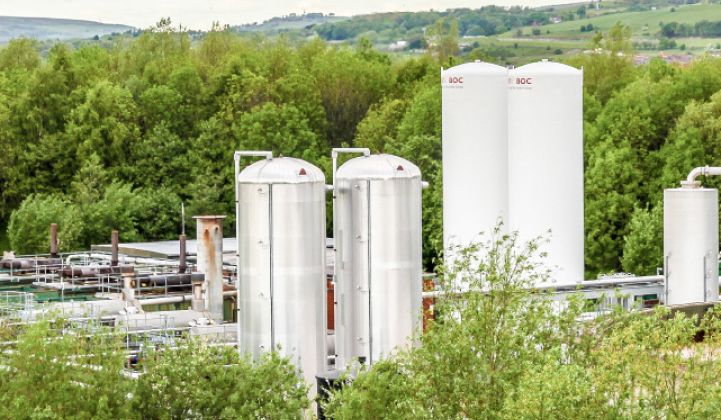A novel long-duration energy storage technology got one step closer to commercialization this week.
U.K.-based Highview Power has completed a test plant for its liquid air energy storage technology. The company uses equipment developed for the conventional power and oil and gas industries to liquefy gas, store it in tanks and release it to spin turbines and produce electricity on demand.
If it works at larger scale, Highview could pull away from the pack of long-duration storage companies challenging lithium-ion’s market dominance.
The periodic influxes of wind and solar power create demand for storing energy longer than is economical with current batteries, but the field of alternatives so far has produced more bankruptcies and small-scale pilots than runaway successes.
Highview has avoided some of these pitfalls. It doesn’t have to convince anyone about a new battery chemistry, because it isn’t using one. Instead, it repurposes equipment from conventional energy infrastructure, which means it can access mature supply chains with bankable suppliers.
“It provides comfort to the customer base that they’re using [equipment] that has a proven track record,” said CEO Gareth Brett.
The test
Highview Power completed commissioning for a 5-megawatt/15-megawatt-hour demonstration project in the Manchester area. The U.K. government provided £8 million ($10.7 million) to fund this effort, which builds on an earlier 350-kilowatt pilot.
The project took longer to complete than originally planned: When GTM covered the company's partnership with GE in 2014, the demo was expected to begin operations in spring 2015. Issues with some of the components caused the delays, but now everything is performing as expected, Brett said.
The plant's job now is to prove out the technology's usefulness for grid-balancing roles like Short Term Operating Reserve and peak capacity.
“The fact that it isn’t a black-box technology is really important," said Matthew Barnett, director of business development. "It’s not just a laboratory-based experiment."
The new plant looks like a grid-scale project compared to the earlier pilot, but it doesn’t yet earn the title of long-duration storage.
Brett already has his sights on bigger things. The next units he wants to build will be 50 megawatts and at least 200 megawatt-hours. At that scale, the supply chain is healthier and more varied than it is for 5-megawatt plants, he noted.
Highview’s design uses an industrial air liquefier to cool down air, which it stores at around -180 degrees Celsius in low pressure tanks. When needed, the plant releases the air through an expansion turbine that generates electric power.
These parts come from the liquefied natural gas and power plant industries, so they are designed for power-plant scale.
"Once we get one of these 50-megawatt units on the ground, it will be a bit of a revelation for the utility guys, because it’s absolutely of a scale that they can use," Barnett said.
How to not fail
Highview has already survived 12 years, which puts it ahead of numerous short-lived long-duration storage startups.
Its continued survival will hinge on avoiding the traps of this particularly challenging branch of the storage industry.
Liquid air storage most closely evokes compressed air energy storage (CAES), which has been achieved in underground caverns at massive scale. There hasn't been much action on that front recently, because it's hard to find the right spot.
“The holes in the ground are never quite where you want them to be," Brett said.
Some teams have tried to replicate that process in smaller, aboveground tanks, but this has not proven successful. SustainX gave up on its aboveground approach and merged with General Compression, and the buzzy LightSail Energy ran out of cash without achieving much beyond a fancy tank.
Highview’s technology doesn’t rely on special geological formations, so it’s more adaptable than underground CAES. By storing at low pressure in insulated tanks, it avoids the hurdle of maintaining infrastructure at high pressure.
Long-duration storage startups also struggle to gain the confidence of large, conservative customers looking for assets to last decades.
Highview addresses this by sourcing from established suppliers like GE and Siemens, and partnering with established companies for engineering, procurement and construction. Earlier this year, Highview partnered with SNC-Lavalin for EPC services in the North American market, hinting at future expansion across the pond.
Then there's the pricing. Unconventional battery companies have staked out low price points for longer-duration storage, only to have the commoditized lithium-ion muscle them aside faster than anyone expected. Aquion, Alevo, ViZn and many others can attest to the risks of making that bet.
With all the heavy equipment involved, liquid air storage looks a lot more like building a traditional power plant than plopping some battery-filled containers on an empty lot. That likely means a higher capital expense upfront.
At the 50-megawatt scale, Highview can deliver a "compelling" upfront price, Brett said. But the technology really shines on the levelized cost of energy, he added, because it stays strong over a much longer lifetime than current batteries. Even at the end of life, the metal equipment is much easier to recycle than lithium-ion batteries.
Ever larger amounts of renewable generation call for cheap bulk storage on the grid — or lots of gas peakers. Highview still has a lot to prove before it can fulfill that need, but at least there isn't a clear long-duration competitor blocking its lane.




